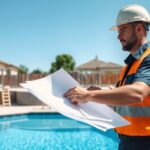How to Balance Pool Chemicals Safely—this UK-focused guide explains exactly what to do, why it matters, and how to avoid common mistakes. Follow the checklists, keep simple records, and your water will stay clear, safe, and inviting.
[LINK: /guides] with real internal links to speed up indexing.Safety First: PPE and Handling
Safety First: PPE and Handling: In this section we cover practical, step-by-step actions tailored to typical UK pools. Focus on consistency over perfection: test, adjust in small increments, document your results, and refine the routine as seasons change. Use internal links to deepen the journey—[LINK: /guides] and [LINK: /contact] for help.
Action Steps
- Test water and log results weekly.
- Adjust in small increments; retest after 6–12 hours.
- Brush, skim, and vacuum on a fixed schedule.
- Audit your equipment each month for leaks and wear.
The Correct Order of Adjustments
The Correct Order of Adjustments: In this section we cover practical, step-by-step actions tailored to typical UK pools. Focus on consistency over perfection: test, adjust in small increments, document your results, and refine the routine as seasons change. Use internal links to deepen the journey—[LINK: /guides] and [LINK: /contact] for help.
Action Steps
- Test water and log results weekly.
- Adjust in small increments; retest after 6–12 hours.
- Brush, skim, and vacuum on a fixed schedule.
- Audit your equipment each month for leaks and wear.
Understanding Core Parameters
Understanding Core Parameters: In this section we cover practical, step-by-step actions tailored to typical UK pools. Focus on consistency over perfection: test, adjust in small increments, document your results, and refine the routine as seasons change. Use internal links to deepen the journey—[LINK: /guides] and [LINK: /contact] for help.
Action Steps
- Test water and log results weekly.
- Adjust in small increments; retest after 6–12 hours.
- Brush, skim, and vacuum on a fixed schedule.
- Audit your equipment each month for leaks and wear.
Avoiding Overcorrections
Avoiding Overcorrections: In this section we cover practical, step-by-step actions tailored to typical UK pools. Focus on consistency over perfection: test, adjust in small increments, document your results, and refine the routine as seasons change. Use internal links to deepen the journey—[LINK: /guides] and [LINK: /contact] for help.
Action Steps
- Test water and log results weekly.
- Adjust in small increments; retest after 6–12 hours.
- Brush, skim, and vacuum on a fixed schedule.
- Audit your equipment each month for leaks and wear.
Record-Keeping for Stable Water
Record-Keeping for Stable Water: In this section we cover practical, step-by-step actions tailored to typical UK pools. Focus on consistency over perfection: test, adjust in small increments, document your results, and refine the routine as seasons change. Use internal links to deepen the journey—[LINK: /guides] and [LINK: /contact] for help.
Action Steps
- Test water and log results weekly.
- Adjust in small increments; retest after 6–12 hours.
- Brush, skim, and vacuum on a fixed schedule.
- Audit your equipment each month for leaks and wear.
Frequently Asked Questions
- What is the ideal pH for pools?
- Typically 7.2–7.6. Aim for the middle to cushion daily swings.
- Should I add chemicals at night?
- Adding in the evening reduces UV breakdown (especially chlorine) and keeps swimmers away while chemicals disperse.
The key to stress-free pool ownership is routine: small, regular actions beat occasional overhauls. Bookmark this guide, share it with your family, and build a simple maintenance log so issues never snowball.
Continue learning: Maintenance Hub • Product Reviews • Contact Us


